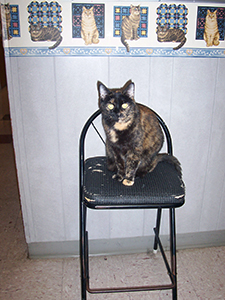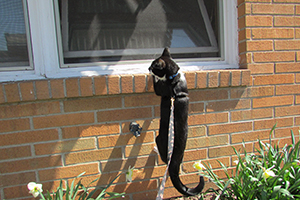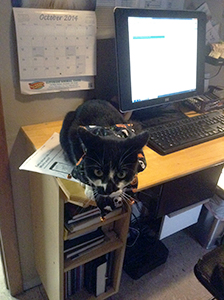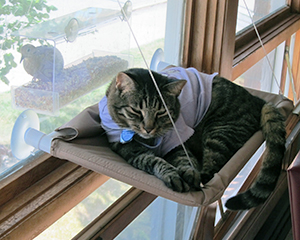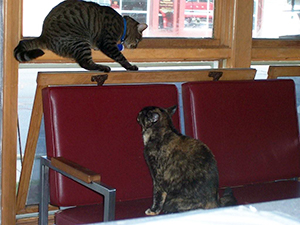Companion animal behavior consultants have a saying: “You better like cats who urinate outside of the litter box. This is the bread and butter of feline behavior.” Very true. A behaviorist is contacted not for the first or fifth offense, but later, after much damage has been done to the home. Recognizing how stress impacts the urinary system of cats, veterinarians turn to feline behaviorists to help reduce this stress, especially when Feline Idiopathic (Interstitial) Cystitis is diagnosed.
Feline Idiopathic Cystitis (FIC) is a physical, medical, and behavioral problem that results in on again/off again bouts of painful urination. Sudden onset of frequent and bloody urination is common. The inflammation in the bladder and urethral lining is real. Cats will repeatedly go to the litter box or other areas, crying in pain as they pass tiny amounts of urine. Pain flares up due to the bladder lining inflammation activating. This painful sensation occurs as the cat uses the litter box and then begins associating that feeling with the box, thus avoiding it. The cat must urinate, so they will find some spot that is more appealing. This may be a closet corner, on a couch where they lay, on your bed, or in the bathtub. Often the cat is urinating in multiple places due to the frequency they need to urinate, and because they are trying to find a spot where they have not felt pain while passing urine.
Diagnosis is determined after a urinalysis, culture, x-ray, or ultrasound is performed. These tests are needed to rule out bladder stones, infection, or abnormalities in the bladder or urethra. If these results are negative, then we are left with the diagnosis of Idiopathic Cystitis. In short, there is not a defined cause. This diagnosis tends to be a frustration for both owners and veterinarians because it is easier to manage a problem when you know the cause. A definitive diagnosis often has predictable responses to medication, a prognosis and clear understanding of the symptoms. Today we know more about managing FIC, yet the plan for your cat will take a multi-modal approach specific to your cat.
Advances in FIC research have shown the interaction of the affected cat’s physiological and neurological responses to stress, resulting in bladder inflammation. When stress is present, the affected cat’s results increased norepinephrine. Increased norepinephrine activates other body systems resulting in triggering the urinary nervous system leading to increased inflammation and pain. There may be a predisposition for some cats to be more affected by stress in the urinary system than other cats. When the stressor is decreased, the inflammation will decrease and thus the blood and pain reduces without other treatment. This is the on again/off again course of the disease. You may miss the physical signs of pain and think your cat is only being naughty, yet the inflammation and pain are real.
Here is where the frustration of inappropriate elimination and veterinary recommendation can clash. The current advice is to enhance the environment at home to reduce stress for 1 week, then if the signs persist start medications to reduce inflammation or behavior modifying drugs. In my veterinary experience, this is not enough relief of stress for both the cat and the owner. Yes, there is not a need for antibiotics and if one gives the environmental enrichment a few days, the pain and stress do decrease. Yet in real life, one more pass of urine on the living room carpet may mean demand for euthanasia for this cat whether direct or by surrender to a shelter. The client expects a veterinarian to use some kind of medication to help quickly reduce the pain or blood because this cat is in need now. Waiting a few days for improvement before starting meds is often not acceptable – and I feel the same.
So how do we balance the need for fast improvement to reduce pain and inflammation and that of identifying the stressor in the home to make the needed changes? Oral analgesics can often reduce stress and are indicated for immediate care. Buprenorphine is often prescribed and small doses given in the cheek pouch at the exam can provide some immediate relief. If your cat is stressed by taking oral medications please tell your veterinarian BEFORE they prescribe any. We do have other options such as injectable medications that can be given at home, or transdermal gels. The stress of getting medication into a cat can often negate the benefit. Please let your veterinarian know how tolerant your cat is to handling. You can follow some of the steps in the Low Stress Handling, Restraint & Behavior Modification of Dogs and Cats book (Chapter 20) to see how to positively condition a cat to take medications and injections.
Environmental Enrichment is the answer to this feline dilemma. Adding perches, increased number of litter boxes, playtime with human, and reducing inter-cat tension or human tension around the cat are all part of that plan. A great resource is the Indoor Cat Initiative, a website through the Ohio State College of Veterinary Medicine. The challenge is that we are asking the owner to change the home and lifestyle with the cat. This means changing human behavior as well as cat behavior. It is easier to give a medication and hope all gets better. In my experience, focusing on easy, immediate strategies to reduce stress, pain and bladder inflammation can resolve symptoms quickly.
From my veterinary experience, these are the immediate changes, listed in the order of importance, most owners can do to reduce stress.
- Increase water intake.
- At the next meal, start adding in 1–2 tablespoons of bottled water to canned food, pouch food, or even dry food. Continue this at every meal.
- Leave multiple small bowls of water that are changed 2–3 times a day with bottled water from the refrigerator.
- Increasing water intake is often the most powerful change to improve FIC.
- At the next meal, start adding in 1–2 tablespoons of bottled water to canned food, pouch food, or even dry food. Continue this at every meal.
- Added litter boxes.
- Put a litter box on each floor.
- A disposable lasagna pan is low sided, can be temporary, and is larger than most boxes making it more desirable to your cat. This is an example of an inexpensive option.
- This MUST be cleaned of all urine and stool 2–3 times a day for every box.
- We want to attract these cats to the box frequently to empty that inflamed bladder.
- Put a litter box on each floor.
- Change the diet.
- Use products like the Calm Diet by Royal Canin or C/D Stress by Hill’s Prescription Diet, both of which contain the supplements to reduce anxiety without the added stress of daily medication.
- In canned form, you can easily add water which enhances their water intake as well.
- Use products like the Calm Diet by Royal Canin or C/D Stress by Hill’s Prescription Diet, both of which contain the supplements to reduce anxiety without the added stress of daily medication.
- Add more cat space and activity.
- Add more perches and 10 minutes of play per cat in the home by humans daily.
- Get those toys on a stick, laser lights, or fuzzy balls out DAILY and play with your cat; just batting at the toy still counts for breaking boredom in your cat.
- If you have a cat who stalks or chases the cat with FIC, immediately toss a ball or get a toy out for that bully cat to attack instead of the affected cat.
- Often a stressor is another home cat who is staring at the affected cat.
- Play and redirection can reduce this pestering thereby reducing the stress on the affected cat.
- Get the collectibles and other items off the sofa table, top of the bookshelf, or back of the couch to increase perching places for your cat.
- Add more perches and 10 minutes of play per cat in the home by humans daily.
- Use the Feliway marking pheromone spray on all 90-degree corners to aid in social marking.
- Doorway trim.
- Table legs.
- Furniture.
- Doorway trim.
Advances in FIC research have shown the interaction of the affected cat’s physiological and neurological responses to stress, resulting in bladder inflammation. When stress is present, the affected cat’s results increased norepinephrine. Increased norepinephrine activates other body systems resulting in triggering the urinary nervous system leading to increased inflammation and pain. There may be a predisposition for some cats to be more affected by stress in the urinary system than other cats. When the stressor is decreased, the inflammation will decrease and thus the blood and pain reduces without other treatment. This is the on again/off again course of the disease. You may miss the physical signs of pain and think your cat is only being naughty, yet the inflammation and pain are real.
There are many more ways to enrich the environment for the cat, and a personal plan for your home is best for long term management of FIC. In my clinical experience, an owner should be able to make the above changes on the first day. With these changes in place, the signs of FIC will resolve quickly. Keeping these changes in place as you work out the full plan for your home, is the key to preventing relapse. Rechecks with your veterinarian and regular medication to help manage pain and anxiety may also be needed, depending on the specifics of your cat. Stick with the plan of environmental enrichment, nutrition, and medication to prevent relapse.
Food Games:
Making Your Own Litter Box:
Additional Reading and Resources:
- What is My Cat Saying? by Jaqueline Munera (CD – Powerpoint Presentation)
- The Body Language of Feline Anxiety (poster)
- CATalyst Council
- Indoor Cat Initiative – a service of the Ohio State University, College of Veterinary Medicine
- Feline Idiopathic Cystitis – International Cat Care
- Updates on Idiopathic/Interstitial Cystitis in Cats by Dennis J. Chew, DVM, DACVIM


